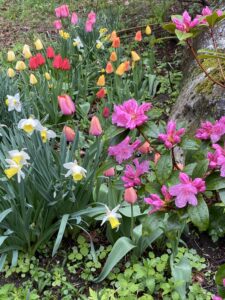“Wake now discover that you are the song that the morning brings.” – Robert Hunter
The ashram was having a problem with mice, so the guru brought home a good cat. The cat did a fine job on the mice but she became attached to the guru and would follow him everywhere, even when he was performing his morning meditations. In order to keep the cat from disrupting his meditations, the guru took to tying the cat to a post.
The guru eventually died, and his students decided to continue with his “tradition” of tying the cat. The cat too later died, and a new cat was obtained so that she could now be tied to the post. The post rotted, so a new post was constructed in order that the cat could continue to be tied. Over successive generations different sects formed based on the type of cat to be tied, the type of rope to be used when tying, and the color paint used on the post. As you can imagine, today these sects are convinced they are following the founder’s true teachings, while the other sects are ignorant blasphemers. Meanwhile, because the cats are always being tied, the mice enjoy the run of the ashrams.
One famous teacher confessed to “selling water by the banks of the river.” How honest. Because all a real spiritual teacher does is reflect back to the student his inner being and the folly of his external search. Like the fabled musk deer that runs all over the forest searching for the beautiful fragrance, most students seem determined to run to exhaustion before collapsing on the ground and realizing the true source of the magnificent scent. All an authentic teacher can do is encourage the student in his pursuit and try to remind him that his own self is what he is seeking.
The yogic tradition holds that every human being has a fullness within that is the source of love, joy, and peace. Called by different names, this source is one’s true spiritual self, unscathed by the tribulations and hassles of life. Most people find it incredulous that their deepest identity is loving and peaceful, as we are more apt to experience ourselves as angry and stressed. The yogis acknowledge our present suffering, but state that it is simply a superficial experience that arises due to a series of five psychological dynamics which are called kleshas, or obstructions.
The first klesha is avidya, which refers to a primal ignorance. We’ll return to the nature of this ignorance later, for now simply consider it the dynamic by which the individual forgets his intrinsic fullness. By the force of avidya, a feeling of emptiness arises as one forgets his spiritual identity. As a response to the pain of this forgetfulness, the second klesha , asmita, then occurs. Asmita is the creation of, and attachment to, a limited identity based primarily on biological and social conditioning.
Under the influence of asmita, an individual identifies himself with a set of definitions which narrow his ability to understand himself and relate to others. This is generally what we would call “ego,” the feeling of being an isolated individual in an enormous world filled with those different from oneself. We see this in the way people feel estranged from those of “other” races, religions, or creeds. Asmita also generates a dualism which produces the third and fourth kleshas– raga and dvesha, attraction and repulsion. Under raga and dvesha, we seek for those external objects and relationships which we incorrectly believe can fill the inner void, and we attempt to repel experiences and people who we believe can disrupt our lives. The end result of this process is the fifth klesha– abhinivesha, fear of change, especially the fear of death. This fear permeates our lives as we are afraid to let go of whatever security we feel we have. Abhivesha produces an anxiety that things can always get worse, so cling tight to whatever little, tentative happiness you may chance to find.
Why do the kleshas exist? Why this wheel of life, with its incessant spin of life and death? Sensitive people often ask, “If God is all -powerful, couldn’t He have created something more pleasant?” Why evil? Why pain? Why sickness? From the yogic perspective these are excellent questions. In fact, when these types of questions arise it is a sign the individual is developing a spiritual maturity. The next step is dealing with the answers.
I once had an argument with Baba Hari Dass, my yoga guru, about the nature of suffering. In front of a fairly large group of people, I put forth my premise that, basically, God is cruel. After all, if the best the creator can do is produce a world in which suffering and disappointment is the norm, in which cruelty can conquer kindness, and in which too many people feel life is passing by without answers to their deepest questions, well, maybe God is a jerk.
Hari Dass tried philosophy, he tried encouragement, he tried to ignore me, but I wouldn’t let up. I wanted to know why suffering exists and how I could bring an end to it in my life! Finally, he said, “Relax, try to enjoy.” At the time I was not satisfied with his answer. I closed my case with the pronouncement “I will never worship whatever God created this world.” I got up and left. Most of the audience was aghast at my seeming blasphemy and rudeness. Hari Dass chuckled, and even then I sensed that though he may not have been able to praise my understanding, he appreciated the passion of his student.
In the years since this event, I have learned that Hari Dass had given me a very profound teaching. One which, at the time, I did not have “the ears to hear.” For I have since realized that suffering and tension are two parts of the same coin. They are like the wave and trough, they arise together in a codependent manner. The more suffering, the more we grow tense. The more tension, the more we armor ourselves against the world and generate a self-fulfilling prophecy of increased suffering. It took years of practice before I could appreciate the wisdom of relaxing.
The world appears to us as an abode of suffering when we are under the influence of avidya, the primal ignorance. This ignorance, however, is nothing more than a knot of tension deep in our being. Avidya is a phenomenon of nature that arises with creation. We may not appreciate all aspects of nature, but ours is not to evaluate but to learn how to live in harmony. Our task is not to destroy our ignorance, but to let it find it’s place in the totality of who we are. In this way we are kept humble. Because we acknowledge we are prone to mistakes, we can accept that we require guidance and supportive friends.
All of us, in the unenlightened state, are conditioned by the five kleshas. The suffering we experience under their influence is painful, but it also brings about a positive outcome. Suffering is nature’s way of motivating us to seek for answers regarding the cause of suffering and its remedy. In the midst of tough times we certainly wonder if nature couldn’t have perhaps come up with a better plan! But nature’s plan is the divine plan, and through spiritual practice we can come to glimpse this plan and participate in its expression.
When we are tense we suffer. To relieve this suffering we chase after externals. This perpetuates the cycle of tension and suffering. The way out is to undo the knots of tension. This is entirely an inner process. It will not be found in objects, in relationships, in churches, ashrams or temples. It will not be found in tying up cats or buying water along the riverside. It will be found within you, as you. You are the song you are yearning to hear. Relax, hear it’s sweet song, try to enjoy.




